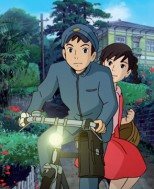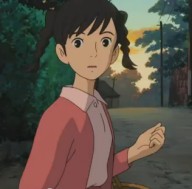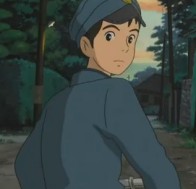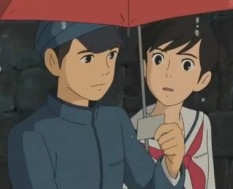The hill of poppies

The hill of poppies
ï ¿½ Studio Ghibli |
Japanese director Goro Miyazaki returns to the big screen with the new animated film "The hill of poppies"produced by studio Ghibli, which will be released in cinemas all over Italy only for the date of November 6, as a unique event. After its debut with"the Tales of Terramare"In 2006, the director worthily continues his father's tradition with this beautiful film, made by Studio Ghibli, now an established film studio specializing in the Anime genre, which has linked its name to successful films and short films such as the Enchanted City, ponies, Arrietty o Howl's Moving Castle. The music is by Satoshi Takebe and the feature film will be presented to the Italian public in preview at Lucca Comics scheduled from 1 to 4 November at the large section dedicated to Japanese manga and cartoons.
In “La Collina dei Poveri” the central theme is the evolution of Japan, after the disastrous defeat suffered in the Second World War. The film narrates, in fact, the historical and cultural situation present in the nation in 1963, the year preceding the Olympics held in Tokyo, and which allowed to show the whole world the rebirth of the Japanese nation. All of this is shown through every single detail of the story and characters.
The history of the film

Umi Matsuzaki
ï ¿½ Studio Ghibli |
The Second World War has been over for 18 years, Japan has carried out a real miraculous resurrection from the ruins, both material and cultural (especially as regards its traditions), and is in the midst of rapid economic growth. Almost as a symbol of rebirth, people are beginning to break all old patterns, believing that only the new will make Japan great again. In the Cartoon all this can be seen from various aspects: the dust of the cars on the crowded streets, the city full of people with, as a background, the noise of the construction and demolition of buildings. A vital city, therefore, that wants to leave behind the horrors of war and the atomic bomb.
It is in this scenario that the story of Umi and Shun takes place, two boys from Yokoama who find themselves sharing the blue sea, green meadows and a vision of the world full of hope.
Umi 'Mer' Matsuzaki is a girl who lives on a hill, called "the hill of poppies", in an area converted from a former hospital, together with her grandmother, Hana Matsuzaki, and her brothers, as well as two ladies no longer young people who have rented a room.
Umi is orphaned of her father, who died during the war fought in Korea when the ship he was on sank hit a mine, while his mother works in the United States as a university teacher. Despite a thousand difficulties, Umi manages to look after all the family members (her sister Sora, her brother Riku and her grandmother) and the other occupants of the house practically alone, preparing breakfast and doing all the housework and in the afternoon she comes later helped by a maid paid by her grandmother. Umi, in memory of her father, every morning raises the sea flags "U" and "W" on the flagpole placed in front of her house, which together mean "wish for safe navigation"; having the house on the hill overlooking the harbor and the whole coast, these flags are visible from all boats and all ships approaching the mainland.
Right on one of these boats is Shun Kazama, a 17-year-old boy who, living on a nearby island, arrives at school by bicycle after being left at the port by his father's tug and who is intrigued by that strange message; Shun being the person in charge of the school newspaper, he publishes a thought about those strange flags on it, responding to Umi's message by hoisting the same flags together with the one that means "Response" on the mast of the tugboat; Umi, thanks to the attention of her friend Sachiko, an art student and also a guest of the house, notices those flags on the tugboat and thinks they may be in response to those hoisted in front of her house. The girl confides in her grandmother and she, as a wise and affectionate woman to her granddaughter, replies that she hopes she will soon find a wonderful boy so as not to need those flags.
Since Umi and Shun go to the same school, fate would have brought them together sooner or later. The two in fact meet thanks to Umi's little sister who asks Shun for an autograph and Umi thus discovers that the boy is responsible for the edition of the school newspaper. Due to a hand injury to Shu and a chance encounter on the hill as he passes by on his bicycle, Umi joins the "editorial team" to give his help.

Shun Kazama
ï ¿½ Studio Ghibli |
From this moment the children live two stories in one: the first is the school one, with the various vicissitudes related to the "Quartier Latin", an old wooden house of the school inside which there are the offices of the school philosophy and astronomy clubs and with the heated discussions for its demolition or its safeguard; the second is the personal one, with the various feelings that slowly take place in the souls of the two young people together with the many vicissitudes and discoveries they make about them and their past.
The "Quartier Latin", thanks to the decision of the school council, must be demolished to make way for a new building. But this house, symbol of the traditions of Japan, guardian of the memories of all those generations who lived before and after the Second World War, of their stories, their acquaintances, their loves and their lives, would thus disappear forever. The school is in turmoil. The decision of the school authorities does not agree with some students who, after heated discussions and various assemblies, thanks also to the heartfelt commitment of Umi, decide to protest against this decision by going to restore the old multi-storey building to be able to bring it back to its former glory. therefore trying to safeguard all that that place means not only for them, but also for all those who have frequented it. The students then begin to work in order to fix the "Quartier Latin". Armed with a face mask for the enormous amount of dust accumulated over the years, a broom and a duvet, the boys put away years of neglect and disorder with true self-denial, moving furniture and tons of books and paper, not without discovering also small secrets and funny anecdotes of the place, but above all with a lot of fun also thanks to a test of courage by Shun who, during a break for lunch, throws himself into a small swimming pool from the roof of the main building to impress Umi while his classmates with the inseparable camera immortalize the undertaking. As the work continues, Umi and Shun have the opportunity to deepen their friendship, starting to talk more often and getting to know each other better, thus discovering that they have many similarities. Day after day the two boys confront each other, until Umi tells Shun about his father, how he died and the meaning of the flags raised in front of the house, and shows Shun an old photo with three men in uniform; Shun is very surprised to see that photograph in Umi's hands, as he has an identical one. Shun then begins to do research and discovers the truth: Umi's father is also his father who, when he was a baby, entrusted him to his current parents; because of this discovery the relationship between Umi and Shun begins to be different, as Shun tends to be less expansive and colder towards Umi who, in the state of the discovery just made, makes her not a stranger, not a ' friend but even her sister.

Shun and Umi
ï ¿½ Studio Ghibli |
Umi is struck by this change and suffers from it not understanding the reason until, during the descent towards home, in the pouring rain Shun shows Umi the same photograph in his possession and tells her the truth, that is, that Yuikiro Sawamura was the her real father adding, in a very sad way, that the two of them were the protagonists of a melodrama also of poor quality: Umi does not understand immediately and Shun tells her briefly and dryly that they are actually brother and sister.
Umi comes out confused and bewildered by the gravity of this news but, as the works of the "Quartier Latin" by all the students who had taken part in its reconstruction and its remaking are coming to an end, the frenzy and excitement take momentarily the upper hand on the whirlwind of feelings she feels and she throws herself headlong into the restructuring of the "Quartier Latin". When the house is finished, the boys, full of pride in their work, go to school but learn that all their effort and all their work would be useless as one of the most powerful financiers of the school, the chief executive Tokumaru , had already decided to demolish the "Quartier Latin" in order to build a new and modern building in view of the Olympics that would be held the following year. Umi participates in the student assemblies to decide on what to do to prevent the "Quartier Latin" from being permanently lost and the final decision is that she, together with Shun and Shiro, Shun's greatest friend, try to speak directly to Tokumaru trying to convince him to desist from his intent. The trio starts in the city and manages to talk to Tokumaru who at first seems adamant about his decision, but when Umi relies on the memories of that place and asks Tokumaru to go and see the work done by the students, he accepts and gives their appointment for the next day directly at the "Quartier Latin". While they wait for the trolley bus to go home, Umi and Shun, left alone, realize that despite being brother and sister, it would be difficult for them to counteract different kinds of feelings that slowly but surely surface and that are taking over in the hearts of both. Umi's mother, Ryoko, meanwhile, returns from the United States with great joy of the girl, not only because she has her family united, but above all because she has the possibility to ask what is beating hard in her head or the truth about Shun and about his father. Ryoko explains not without difficulty to Umi that Shun is her brother only because Shun's natural father and his were great friends and when his dad learned of his friend's death during the Korean War, to prevent Shun from ending up in an orphanage and, having a big heart, she recognized him as her son and gave him in custody to Akio Kazama, a great friend of both, and current father of Shun also because Akio had just lost his little son. Umi is therefore very refreshed by what her mother told her.
Shun arrives at the "Quartier Latin" and tells Umi what his father had told him just before the arrival of President Tokumaru; the latter seeing the work done by the students and having noted that, despite the commitment to restore the "Quartier Latin" all had maintained good conduct and good grades, officially communicates the intention to abandon the project of building a new building in place of the historic "Quarter Latin" since it will be built elsewhere. He also assures the children that he will personally communicate this decision to the school board.

Shun and Umi
ï ¿½ Studio Ghibli |
Happiness among young people is great, but Shun and Umi do not have time to rejoice and take part in the party as they have to rush to the port of Yokoama to avoid losing the only person who can really tell them how things are. about their parents; they rush at full speed to the port and thanks also to the help of Shun's father who accompanies the ship with his tug, the boys can get on and talk to the commander Yoshio Onodera. He tells the boys that they look a lot like their respective fathers and explains to them that he himself, Shun's natural father and Umi's father had met during the Korean War and had become inseparable friends; when Shun's father died, Umi's father in memory of his missing friend took care of Shun until Umi arrived.
Having confirmed that they were not really brother and sister, Umi and Shun return to their homes and their daily activities with a heart free from anguish but above all free to be able to freely express their feelings, with Umi who again, every morning, hoist the flags on the flagpole in front of the house, wishing all sailors the best of luck. In the last scene there is the image of the picture that Sachiko paints and gives to her friend after noticing the response to the waving of the signal flags raised by Umi by the tugboat.
In addition to the passionate and complex events of Umi and Shun, the film tells the story of Japan at the same time, of how the old and new generations have been able to find points of contact in the millenary traditions of that country in a critical moment that sanctioned the definitive customs clearance. Japan from the remnants of the Second World War and which would have led it, within a few years, to be one of the major world economic powers; in every part of the film it is possible to see the contrast between the old and the new, between traditions and progressivism: just think of Umi's house and her family in which the grandmother dresses with a Kimono while Umi wears Western clothes, or the "Quartier latin" which had to give way to a new building, to the cars and traffic of the city as opposed to Shun's bicycle: all to remind people that Japan has its roots very firmly in a past that it does not want to forget. As perceived by the desire and commitment of young people to renovate an old house instead of giving space to a new and more welcoming building.

Shun the crowded city
ï ¿½ Studio Ghibli |
Final judgementThe Hill of Poppies has a simple animation with soft strokes and colors, which differs greatly from current 3D movies full of special effects. An often melancholy atmosphere that accompanies the events, the sweetness of feelings and the ability to focus on calm and never exasperated movements, a sweet and nostalgic music as background, are elements that surround a story that succeeds, with its naturalness , to involve the viewer. Then there is the Value of Memory, a theme that lately is very much felt everywhere. In contrast with modernity, with technology and with a hectic life accustomed to looking only ahead, there is the value of tradition and the recovery of ancient values without which it is not even possible to have a future. The box office record in Japan highlighted the fact that perhaps this nation, despite the very fast race it started after the war towards technological supremacy born from the desire to leave destruction and death behind, has never really wanted to forget its roots rich in millenary traditions without which a people would have no history. A celebration also of their own youth who firmly believe in common ideals and fight with all their strength to achieve a goal. After all, the choice of the period is not accidental. The setting, the one in the immediate vicinity of the Olympics, is precisely the moment in which Japan had to prove to the world that it had overcome the disaster caused by the war. In Japanese cinemas the film was released in 2011 and after more than a year it lands in our cinemas for just one day, distributed by Lucky Red. An important event for fans of the anime genre, it is a pity that the choice to show it in theaters for a very short time could leave out a large part of the public able to appreciate this polite and unobtrusive way of telling important stories
| | Original title: | Kokuriko-zaka kara | | Country: | Japan |
| Year: | 2011 |
| Gender: | Entrainment |
| Duration: | 91 ' |
| Directed by: | Goro Miyazaki | | Official site: | http://kokurikozaka.jp/index.html |
| Production: | Studio Ghibli | | Distribution: | Lucky Red | | Exit : | 06 November 2012 at the cinema | | | |
<
The hill of poppies is copyright Studio Ghibli, Lucky Red and those entitled to it and are used here exclusively for cognitive and informative purposes.
|

